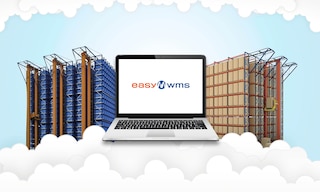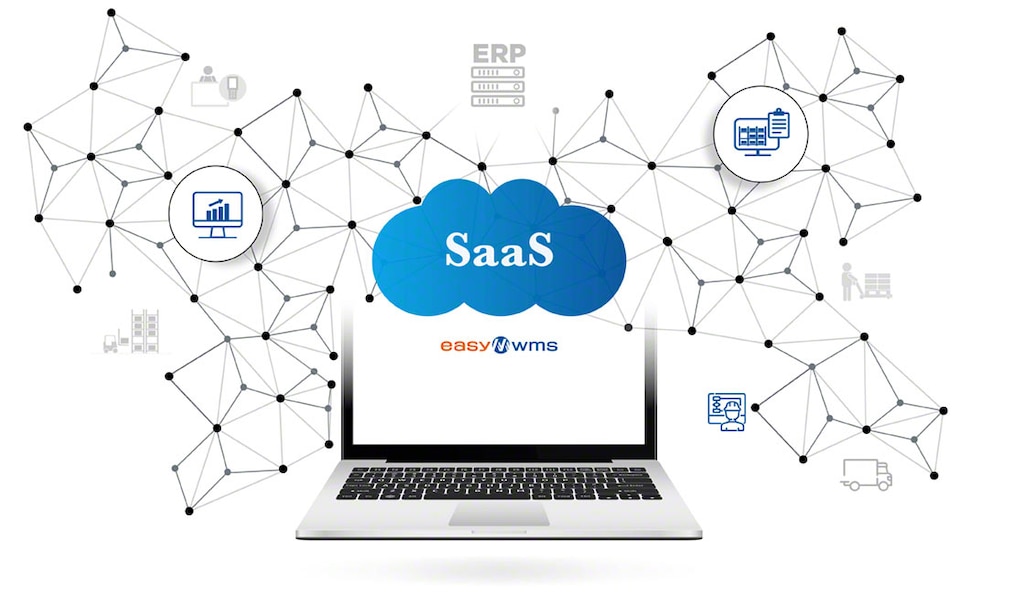
Why use cloud-based inventory management?
Cloud-based inventory management is a very common practice in warehouses. It consists of controlling product entries and exits to and from the warehouse with the help of inventory management software in SaaS (software as a service) mode, that is, deployed in the cloud.
With a cloud-based warehouse management system (WMS), companies can securely store all data relating to their stock on a remote server, accessing the information at any time from any internet-connected device.
According to a study from Grand View Research, businesses prefer cloud-based WMS software because its implementation cost is lower than that of the on-premise modality. The advantages of cloud-based software — among them, cost reduction, increased security, and easy access to the program’s dynamic, advanced functions — are catching the attention of more and more companies.
Here are seven reasons why it’s a great idea to manage your stock with cloud-based inventory management software:
1. Easy installation and user-friendliness
Cloud-based inventory management facilitates the installation of the logistics software: the WMS provider is charged with configuring the workstations and RF scanners to communicate directly with the cloud server.
The only thing the business contracting the software needs is to have a low-latency internet connection and enough bandwidth in each of the devices where the program will be used. This way, the IT department doesn’t have to spend time configuring the computers. In addition, implementation of the WMS and data storage are moved to external servers, so the company doesn’t have to concern itself with the purchase and maintenance of the equipment running the software.
2. Scalability to adapt to warehouse changes
Another benefit of cloud-based inventory management is scalability: the SaaS mode makes it possible to expand or reduce software functionalities whenever required to adapt to the changing needs of the logistics facility (for example, during seasons with larger or smaller numbers of orders to prepare).
The SaaS model also allows for a variable number of licenses, giving businesses that choose to manage their inventory this way greater flexibility. Companies can increase or reduce the number of licenses based on their workload and product demand.
3. Inventory visibility in real time
Cloud-based inventory management makes it possible to update stock levels in the warehouse in real time. As a result, the business always knows how much product it has on hand. Updating inventory is extremely simple: new products are entered into the system by scanning their barcodes (generally, the GS1-128).
Once all the goods are identified, the WMS has total visibility of the stock and knows exactly where each item is located. By keeping tight control over the amount of stock in the warehouse, the company can also make decisions to avoid stockouts, organizing replenishment before products run out.

4. Data analysis facilitates inventory management
Data analysis is especially useful for optimal inventory management, as it facilitates improved decision-making and effective demand planning. Cloud-based inventory management software analyzes all warehouse operations and generates reports that enhance future decision-making.
With this information, in addition to predicting adequate goods levels, the business can identify, for example, the best time to introduce new products to the market. Data analysis also lets the company know which merchandise sells the most as well as the availability of products in the warehouse. Moreover, it analyzes important aspects for the company, such as market seasonality and the holidays that most affect sales.
5. Guaranteed security
With cloud-based inventory management, companies benefit from maximum security: the data are stored on external, off-premise servers, and backups are made automatically. This ensures that all the information is properly stored and never disappears.
Cloud-based inventory management software updates information on stock instantly, thus, impeding duplication and order errors.
6. Cost reduction
Cloud-deployed software is subscription-based. With this model, businesses don’t need to concern themselves with the cost of the hardware for storing the WMS or maintenance of the licenses.
This modality also cuts costs by facilitating the work of the operators. Thanks to the WMS, they can check the status of the goods from any internet-connected device without having to travel about the warehouse to confirm the availability of the items.
Another advantage of cloud-based inventory management is that the company doesn’t need its own IT team to take care of the maintenance, backups, or integrity of the database. The software provider is responsible for the system maintenance and security.

7. Omnichannel-ready warehouse
Inventory management is a critical operation for companies with an omnichannel strategy. Organizations that market their products in different channels need to rigorously control their goods to make sure that orders are delivered to customers in the shortest possible time.
Businesses that sell their products via brick-and-mortar stores, websites, or cellphone apps count on cloud-based inventory management. This is because it enables them to expand their functionalities to prepare a larger number of orders from various channels. Likewise, the software can also be upgraded with specific modules that connect the warehouse with the online stores where the products are sold.
Cloud-based inventory management with Easy WMS from Interlake Mecalux
Easy WMS, the warehouse management system from Interlake Mecalux, is available in SaaS mode. Its installation is very easy, and its cost, very affordable: it requires no initial investment and involves only a periodic fee based on the number of licenses contracted.
With this solution, many businesses have optimized their warehouses and inventory management. For instance, stationery and office supply store SurDiscount has implemented Easy WMS in SaaS mode to manage its stock. With the help of this software, the company knows the exact location of the 9,000 SKUs stored in its warehouse. Additionally, it has streamlined the preparation of 6,000 to 10,000 orders a month placed via its website.

One of the main advantages of managing inventory in the cloud with Easy WMS is error elimination. Controlling goods inflows and outflows automatically prevents mistakes arising from manual management. Plus, it’s really easy to use: warehouse operators connect to Easy WMS to consult the status of the logistics facility from any computer or RF scanner with an internet connection.
Since it is subscription-based, Easy WMS software calls for a lower initial investment. The program is updated automatically and allows authorized users to add or remove functions according to the company’s supply chain needs.
Many businesses use Easy WMS in SaaS mode to cope with rising orders in their warehouses and to make their supply chains securer and more flexible. Planning on implementing cloud-based inventory management in your warehouse? Be sure to contact us. We’ll show you how Interlake Mecalux software can help you to boost your business.
